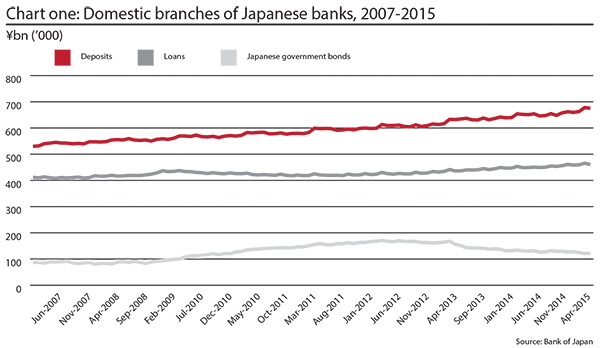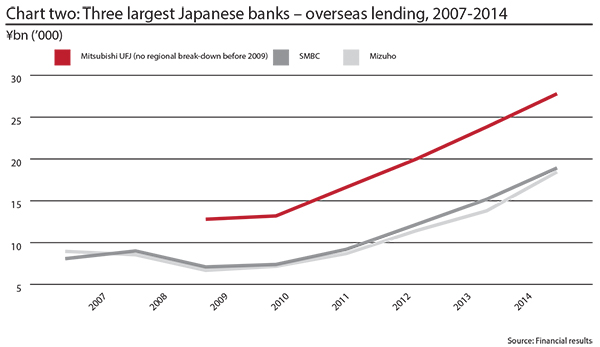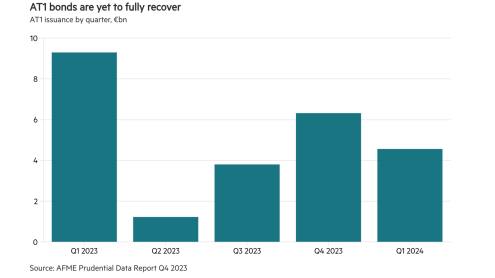Stagnant local demand, low interest rates and a massive domestic quantitative easing (QE) programme are forcing Japanese banks to significantly expand their lending operations abroad, according to data from the Bank of Japan (BoJ) and banks' financial statements.
The recent $3bn purchase of RBS’s American loan portfolio by Mizuho and the pending $244m acquisition of the UBS fund unit by Mitsubishi UFJ are indicators of this trend – one that is aided by the global retrenchment of banks that followed the financial crisis. While European banks have pulled back from Asia and US, lenders have focused on shoring up their capital bases, and the Japanese, who largely avoided the turmoil, have found themselves facing swelling deposits and weakening domestic appetite for loans.
Flat demand
The growth rates in deposits and loans in the home market started to diverge in early 2009 (see chart 1). While deposits continued their steady climb, loans dipped below ¥437,000bn ($3500bn) and did not return to that level until mid-2013.
Profitability was pressured further as Japan's interest rate was cut to 0.1% in December 2008, tightening the screws on net interest margins for banks.
Extra cash on bank balance sheets was initially funnelled into government bonds – holdings of central government securities increased by more than 70% between 2009 and early 2013 within domestic branches of Japanese banks.
From 2013, the situation changed. In April that year, Japan initiated an expansionary QE programme known as ‘Abenomics’ – named after the Japanese prime minister, Shinzō Abe. The BoJ committed to Japanese government bond purchases (currently at about Y7000bn per month), and by the end of the first quarter of 2015, the central bank had in its hands 26.5% of all government securities. The central bank expects the stimulus to last until sometime between April and September next year, when inflation is projected to reach about 2%.
The programme drove Japanese banks out of the government bond holdings they have been building up since 2009, in search of better returns. In April 2015, these holdings were almost 28% lower than two years before, when QE began.
However, this has not translated into a substantial increase in domestic loans – Japanese banks have seen an uptick in this area of just 4.37% since the start of QE. For the domestic mega-banks – Mitsubishi UFJ, Sumitomo Mitsui and Mizuho – the growth has been even more tepid as their total non-consolidated domestic loans inched up by 2.16%. At Mizuho, the number of domestic loans has actually decreased slightly.
Overseas loans offer a very different picture. The mega-banks enjoyed their most expansionary year overseas in 2014, as their loans grew by Y12,370bn – bringing total foreign lending to Y65,000bn.
It also appears that mergers and acquisitions abroad are still in the ascendancy for the Japanese banks and the rest of corporate Japan. According to Dealogic, halfway through this year Japan outbound mergers and acquisitions reached the highest year-to-date volume on record ($53.2bn via 317 deals) – a 69% increase on the previous year.
Borrowing to grow
Overall, overseas lending among the mega-banks has grown more than twofold since 2009 (see chart 2), but while deposits outstripped loans domestically, this was not the case elsewhere.
According to Ryoji Yoshizawa, a banking analyst at Standard & Poor’s, the overseas operations of these mega-banks had loan-to-deposit ratios of between 120% and 130%, and consequently have to rely on outside funding.
“Mega-banks are funding their foreign loans by borrowing short term on the interbank market and bond issuance,” says Mr Yoshizawa. “In general, the loan-to-deposit ratio is lower at Mitsubishi because of its US subsidiary, Union Bank,” he adds.
With the BoJ holding interest rates at just 0.1%, this seems a prudent method of financing, although it may open the door to maturity mismatches in the future.













